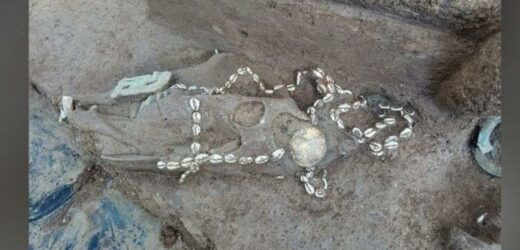Tutankhamun's tomb theories debunked by expert
We use your sign-up to provide content in ways you’ve consented to and to improve our understanding of you. This may include adverts from us and 3rd parties based on our understanding. You can unsubscribe at any time. More info
Archaeologists discovered a complex of 24 tombs at an archaeological site within the city of Anyang in Henan province. The site was less than 2.4 km from the UNESCO World Heritage archaeological site of Yinxu at the city’s centre. The city used to be the capital of the Shang dynasty, which was the earliest dynasty ever recorded in China and reigned between about 1600 BC to 1046 BC.
At the site, researchers unearthed several pits that held war chariots, the remains of horses that drew them and the remains of warriors.
According to a statement from the government’s Xinhua news agency, some of the warriors were found wearing hats decorated with strings of shells when they died.
Meanwhile, the foreheads of some of the horses were decorated with a gold veneer and a bronze backing.
Kong Deming, the director of the city’s Institute of cultural relics and archaeology said: “This is very rare among the ancient discoveries of Anyang, reflecting the extraordinary status and power of the chariot owner.”


A study from Penn State University noted that: “Large-scale, systematic human sacrifice functioned as important political and religious spectacles in Shang dynasty.”
Most of what historians know about this dynasty came from written carvings predominantly in the form of oracle bone script.
These bones, used during state divination ceremonies by priest-kings, contain scripts specifically concerning human sacrifice.
It was also common for personal slaves and servants of the Shang king to commit ritual suicide or to “volunteer” themselves to be buried alive alongside their master, upon their Master’s death.

Archaeologists have been excavating the site at Anyang for two years and have unearthed several sacrificial pits that contained the remains of horses, chariots, and warriors.
They believe that the ancient site was a major living centre for an influential clan called “Ce.”
This clan seems to have been buried there as well, judging by the finely-made bronze vessels inscribed with the Chinese character “Ce”.
According to Kong, researchers have found records about this clan on bone inscriptions in the ancient capital of Yinxu.
DON’T MISS:
Archaeology breakthrough as ancient Japanese tomb mystery unveiled [REVEAL]
Brexit Britain unveils new £200m factory in Yorkshire [SPOTLIGHT]
EU in chaos as Austria prepares to sue Commission over nuclear energy [INSIGHT]


He said: ”The ‘Ce’ clan emblem appears on many of the bronzes found at the site, so we believe that the clan was active in this area.”
The ornate decorations on the bronzeware, along with the presence of fine artefacts made jade, stone, bone and shell suggested that the clan was wealthy.
Although one of the largest tombs in the city was plundered by grave robbers, the other tombs contained relics that are diverse and relatively well-preserved, Kong said.
The researchers now hope to learn more about the social status of the Ce clan, along with their division of labour and their relationship with the Shang royal family.
Source: Read Full Article

